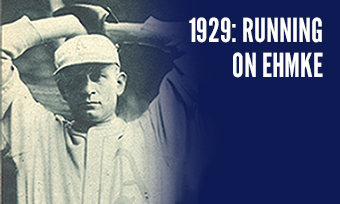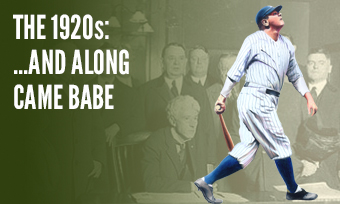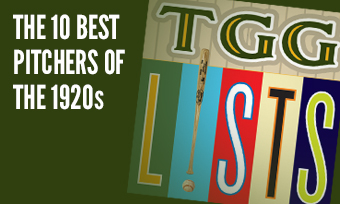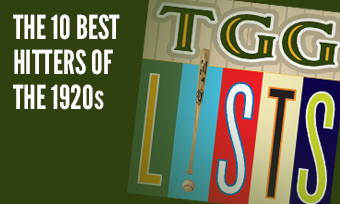The Yearly Reader
Leaders and Honors, 1929
Our list of baseball’s top 10 hitters and pitchers in both the American League and National League for the 1929 baseball season, as well as the awards and honors given to the game’s top achievers of the year.
The National League’s Top 10 Hitters, 1929
Bold type in brick red indicates league leader.
1. Rogers Hornsby, Chicago
Key Numbers: 156 games, .380 average, 156 runs, 229 hits, 47 doubles, 8 triples, 39 home runs, 149 RBIs, 87 walks, .679 slugging percentage.
Playing for his fourth team in four years, Hornsby gave journeymen everywhere a good name by finishing a decade in which he averaged a record 209 hits per season.
2. Mel Ott, New York
Key Numbers: .328 average, 138 runs, 179 hits, 37 doubles, 42 home runs, 151 RBIs, 113 walks.
Few, if any players, have produced dominant numbers at age 20 as Ott did in 1929; some fans thought he’d have a crack at Ruth’s season record of 60 home runs after belting 20 through his first 54 games.
3. Chuck Klein, Philadelphia
Key Numbers: .356 average, 126 runs, 219 hits, 45 doubles, 6 triples, 43 home runs, 145 RBIs.
In his first full season at age 24, Klein tipped Mel Ott for the NL home run crown—and in the process set the league season record that would be shattered a year later by Hack Wilson.
4. Lefty O’Doul, Philadelphia
Key Numbers: .398 average, 152 runs, 254 hits, 35 doubles, 32 home runs, 122 RBIs, .465 on-base percentage.
A disaster of a pitcher earlier in the decade, O’Doul proved a worthy reinvention of himself by setting the NL record for hits.
5. Hack Wilson, Chicago
Key Numbers: .345 average, 135 runs, 198 hits, 30 doubles, 39 home runs, 159 RBIs, 78 walks, 83 strikeouts.
Most players would be thrilled collecting 350 RBIs over three seasons. This was the first of two seasons in which Wilson would gather up that total.
6. Babe Herman, Brooklyn
Key Numbers: .381 average, 105 runs, 217 hits, 42 doubles, 13 triples, 21 home runs, 113 RBIs, 21 stolen bases.
Often remembered for his buffoonish play, Herman’s 1929 numbers were otherwise seriously good.
7. Chick Hafey, St. Louis
Key Numbers: .338 average, 101 runs, 47 doubles, 9 triples, 29 home runs, 125 RBIs.
The season résumé for Hafey included a run of 10 straight hits, which set a major league record for the time.
8. Kiki Cuyler, Chicago
Key Numbers: .360 average, 111 runs, 15 home runs, 102 RBIs, 43 stolen bases.
Freed from Donie Bush’s doghouse in Pittsburgh, Cuyler regained his dynamic form that earlier shot him to instant stardom with the Pirates.
9. Paul Waner, Pittsburgh
Key Numbers: .336 average, 131 runs, 200 hits, 43 doubles, 15 triples, 15 home runs, 100 RBIs, 89 walks, 15 stolen bases.
Waner muscled up for a career-high total in homers—most of them probably inside the park, given the spacious dimensions in his home park at Forbes Field—and for the third straight season grouped with “little” brother Lloyd to each collect 200 hits.
10. Jim Bottomley, St. Louis
Key Numbers: .314 average, 108 runs, 176 hits, 31 doubles, 12 triples, 29 home runs, 137 RBIs.
Of Bottomley’s 29 homers, 12 were hit at Sportsman’s Park—and only three of those were hit from mid-July on after a cyclone fence extension was placed above the right-field wall by the Browns, who owned the joint.
The American League’s Top 10 Hitters, 1929
1. Babe Ruth, New York
Key Numbers: .345 average, 121 runs, 46 home runs, 154 RBIs, 72 walks, .697 slugging percentage.
For the second time in three years, Ruth hit grand slams in back-to-back games; no other AL player would do it until Bill Dickey in 1937.
2. Al Simmons, Philadelphia
Key Numbers: .365 average, 114 runs, 212 hits, 41 doubles, 9 triples, 34 home runs, 157 RBIs, 20 grounded into double plays.
Jimmie Foxx and Lefty Grove may have commandeered the Athletics’ marquee, but Simmons quietly commanded the most attention from weary opponents.
3. Jimmie Foxx, Philadelphia
Key Numbers: .354 average, 123 runs, 183 hits, 9 triples, 33 home runs, 108 RBIs, 103 walks, 70 strikeouts, .463 on-base percentage.
In his first season as everyday player, Foxx was hitting over .400 into early July—and then he went on a 22-game hit streak, in which his average actually dropped to .392.
4. Lou Gehrig, New York
Key Numbers: .300 average, 127 runs, 32 doubles, 10 triples, 35 home runs, 126 RBIs, 122 walks.
Normally considered a shoo-in to hit over .300, Gehrig had to collect 11 hits over his final 26 at-bats of the year to finish right at that figure.
5. Dale Alexander, Detroit
Key Numbers: 155 games, .343 average, 110 runs, 215 hits, 43 doubles, 15 triples, 25 home runs, 137 RBIs.
Setting a then-rookie record for RBIs, Alexander would have had a more memorable career had it not been cut short by severe mistreatment of his leg four years later.
6. Charlie Gehringer, Detroit
Key Numbers: 155 games, .339 average, 131 runs, 215 hits, 45 doubles, 19 triples, 13 home runs, 106 RBIs, 64 walks, 27 stolen bases.
Gehringer had his first of seven career 200-hit seasons and tied teammate Alexander (above) for the AL lead.
7. Harry Heilmann, Detroit
Key Numbers: 125 games, .344 average, 41 doubles, 7 triples, 15 home runs, 120 RBIs.
The future Hall of Famer finished a decade in which he hit .364 and won four batting titles. So how did the Tigers reward him? By waiving him.
8. Tony Lazzeri, New York
Key Numbers: .354 average, 101 runs, 193 hits, 37 doubles, 11 triples, 18 home runs, 106 RBIs, 68 walks.
Almost quietly, Lazzeri continued to be strong supporting cast member in the Yankees’ lineup, producing a career-high batting average.
9. Lew Fonseca, Cleveland
Key Numbers: .369 average, 97 runs, 209 hits, 44 doubles, 15 triples, 103 RBIs, 7 hit-by-pitches, 19 stolen bases.
Fonseca was one of the first major leaguers to get opposing pitchers caught on camera, studying their deliveries to help win the AL batting title.
10. Jimmy Dykes, Philadelphia
Key Numbers: 119 games, .327 average, 76 runs, 34 doubles, 13 home runs, 79 RBIs, 7 hit-by-pitches.
One of the majors’ most active and effective utility players set career highs in batting average and slugging percentage (.539).
The National League’s Top 10 Pitchers, 1929
1. Charlie Root, Chicago
Key Numbers: 3.47 ERA, 19 wins, 6 losses, .760 win percentage, 43 appearances, 31 starts, 272 innings.
Rebounding from a mediocre 14-18 mark in 1928, Root got the winning knack back and became the stingiest component of a strong Cubs rotation.
2. Burleigh Grimes, Pittsburgh
Key Numbers: 3.13 ERA, 17 wins, 7 losses, .708 win percentage.
Still legally riding the spitball after all of these years, Grimes won his first 10 decisions—he was 15-1 by mid-July—in his second and last year at Pittsburgh.
3. Red Lucas, Cincinnati
Key Numbers: 3.60 ERA, 19 wins, 12 losses, 28 complete games, 270 innings, 58 walks, .257 opposing batting average.
While performing a star turn from the mound, Lucas had an intriguing side job: Leading the NL in pinch hits. (He would eventually have 80 over his career.)
4. Pat Malone, Chicago
Key Numbers: 3.57 ERA, 22 wins, 10 losses, 5 shutouts, .688 win percentage, 40 appearances, 30 starts, 267 innings, 166 strikeouts.
There were 10 games in 1929 where a pitcher struck out 10 or more batters—and Malone was the guy in four of them. His league-leading total ended Dazzy Vance’s seven-year run at the top of the charts.
5. Carl Hubbell, New York
Key Numbers: 3.69 ERA, 18 wins, 11 losses, 39 appearances, 35 starts, 268 innings, 67 walks.
Hubbell’s first full-scale assault on hitters included the first no-hitter thrown by a lefty in 11 years—and the last thrown by a Giant until Juan Marichal in 1963.
6. Bill Walker, New York
Key Numbers: 3.09 ERA, 14 wins, 7 losses, .667 win percentage.
Survivor of two heart attacks before the age of 15, Walker began his peak as one of the most unheralded pitchers in Giants history—winning his first of two ERA crowns.
7. Watty Clark, Brooklyn
Key Numbers: 3.74 ERA, 16 wins, 19 losses, 41 appearances, 39 starts, 279 innings, 71 walks.
A former batting practice pitcher for the Indians, Clark held his own as Brooklyn’s most reliable pitcher of the moment despite pacing the NL in losses.
8. Guy Bush, Chicago
Key Numbers: 3.68 ERA, 18 wins, 7 losses, .720 win percentage, 8 saves, 50 appearances, 30 starts, 270.2 innings.
Overwork started to work over Bush after taking a 16-1 record into early August.
9. Freddie Fitzsimmons, New York
Key Numbers: 4.10 ERA, 15 wins, 11 losses, 37 appearances, 30 starts, 14 complete games, 221.2 innings, 27 grounded into double plays.
Fat Freddie had Cincinnati to thank for fattening up his win totals, with six notched against the Reds—including all four of his shutouts.
10. Ray Kremer, Pittsburgh
Key Numbers: 4.26 ERA, 18 wins, 10 losses, 34 appearances, 27 starts, 14 complete games, 221.2 innings.
On the peak of the live ball era, Kremer managed to bring home 18 victories despite a less-than-agreeable ERA. It would get better for the former, worse for the latter a year later.
The American League’s Top 10 Pitchers, 1929
1. Lefty Grove, Philadelphia
Key Numbers: 2.81 ERA, 20 wins, 6 losses, .769 win percentage, 42 appearances, 37 starts, 275.1 innings, 170 strikeouts.
As the live-ball era neared its peak, Grove emerged as the only major leaguer with a sub-3.00 ERA in 1929.
2. Firpo Marberry, Washington
Key Numbers: 3.09 ERA, 19 wins, 12 losses, 9 saves, 49 appearances, 26 starts, 250.1 innings.
Baseball’s ultimate reliever of the day, Marberry was given as many starts as relief roles in 1929—and led the Senators in both wins and saves.
3. Willis Hudlin, Cleveland
Key Numbers: 3.34 ERA, 17 wins, 15 losses, 40 appearances, 33 starts, 22 complete games, 280.1 innings.
The Yankees had long bugged the Indians to nab the double play-inducing ground ball specialist to New York, and here’s why: He was 5-1 against the Yankees in 1929.
4. George Earnshaw, Philadelphia
Key Numbers: 3.29 ERA, 24 wins, 8 losses, .750 win percentage, 44 appearances, 33 starts, 254.2 innings, 257 total bases allowed, 125 walks.
Long before Bill Skowron and Mike Moustakas, the big right-hander was the first major leaguer to go by the nickname of Moose and led the AL in wins during his first full season.
5. Tommy Thomas, Chicago
Key Numbers: 3.19 ERA, 14 wins, 18 losses, 36 appearances, 24 complete games, 259.2 innings, 60 walks.
Thomas finished third in the AL ERA race but tied for fourth in losses; something just didn’t add up.
6. Wes Ferrell, Cleveland
Key Numbers: 3.60 ERA, 21 wins, 10 losses, .677 win percentage, 5 saves, 43 appearances, 25 starts.
Barely 21, rookie Ferrell threw like a star veteran—and kept throwing like one in the first of four years winning at least 20 games.
7. Jake Miller, Cleveland
Key Numbers: 3.58 ERA, 14 wins, 12 losses.
Though he barely registers in the minds of even the most noted of Cleveland baseball historians, Miller—who enjoyed his most productive year with the Indians—should get plaudits for establishing a career 3.27 ERA at cozy League Park.
8. Rube Walberg, Philadelphia
Key Numbers: 3.60 ERA, 18 wins, 11 losses, 40 appearances, 33 starts, 267.2 innings.
Walberg’s continued improvement made him one of many prime talents to slip away from the Giants during the 1920s.
9. Danny MacFayden, Boston
Key Numbers: 3.62 ERA, 10 wins, 18 losses, 4 shutouts.
The year’s hard-luck pitcher award goes to the young Cape Cod native who had to practically earn every one of his precious victories for a lousy Red Sox team.
10. Sam Gray, St. Louis
Key Numbers: 3.72 ERA, 18 wins, 15 losses, 43 appearances, 37 starts, 23 complete games, 305 innings, 4 shutouts.
As Gray went, so went the Browns; after this stellar workhorse effort, he went 29-55 over the next four seasons—and the Browns wouldn’t have another winning season until 1942.









